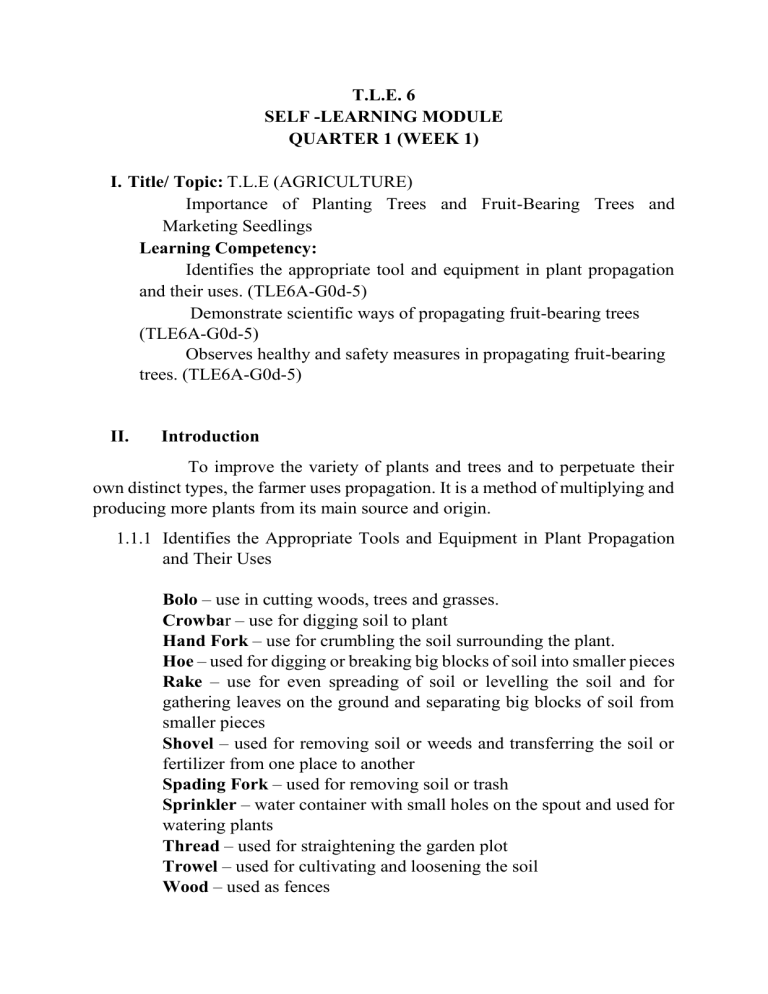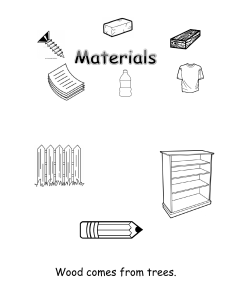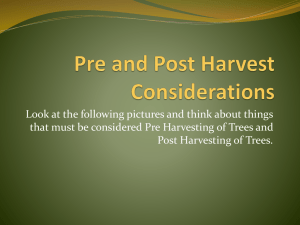
T.L.E. 6 SELF -LEARNING MODULE QUARTER 1 (WEEK 1) I. Title/ Topic: T.L.E (AGRICULTURE) Importance of Planting Trees and Fruit-Bearing Trees and Marketing Seedlings Learning Competency: Identifies the appropriate tool and equipment in plant propagation and their uses. (TLE6A-G0d-5) Demonstrate scientific ways of propagating fruit-bearing trees (TLE6A-G0d-5) Observes healthy and safety measures in propagating fruit-bearing trees. (TLE6A-G0d-5) II. Introduction To improve the variety of plants and trees and to perpetuate their own distinct types, the farmer uses propagation. It is a method of multiplying and producing more plants from its main source and origin. 1.1.1 Identifies the Appropriate Tools and Equipment in Plant Propagation and Their Uses Bolo – use in cutting woods, trees and grasses. Crowbar – use for digging soil to plant Hand Fork – use for crumbling the soil surrounding the plant. Hoe – used for digging or breaking big blocks of soil into smaller pieces Rake – use for even spreading of soil or levelling the soil and for gathering leaves on the ground and separating big blocks of soil from smaller pieces Shovel – used for removing soil or weeds and transferring the soil or fertilizer from one place to another Spading Fork – used for removing soil or trash Sprinkler – water container with small holes on the spout and used for watering plants Thread – used for straightening the garden plot Trowel – used for cultivating and loosening the soil Wood – used as fences Wheelbarrow – used for hauling fertilizer and soil for carrying other tools and materials. 1.1.2 Demonstrate Scientific Ways of Propagating Fruit-Bearing Trees SEXUAL METHOD – a natural method done by sowing the seeds directly to the soil. To ensure good quality of plants and high yields, properly choose the seeds. Most plants propagate sexually through seeds, which are produced in the flowers of the grown trees. ASEXUAL METHOD – a process of reproducing plants from the parts that grow from the mother plat, like bulb, sucker, tuber, root sock, slip and rhizome. This method includes cutting, grafting, marcotting, inarching, budding, and layering. a. CUTTING – this is the easiest and simplest of all methods where new plants are produced and multiplied by cutting. 10 inches of stem is cut from the, other tree. The leaves are removed from the stem and one half of the cutting is inserted into soil. b. GRAFTING – this is an artificial vegetative process of propagating trees. The stem of one plant (mother plant) of a good variety is connected and inserted into another plant, usually a seedling, making the two units form another plant. Mango, guava, pomelo, rambutan and santol trees are propagated. c. MARCOTTING OR AIR LAYERING – this done by inducing the stem to develop roots while still growing on the mother plant. The branch is peeled off scraped before soil is put around it. It is covered with plastic and water daily when the roots appear, the branch is cut and planted in the soil. d. INARCHING – two plants growing on their own roots are joined together. The kind of plants and the climatic conditions of the place determine the growth of the new plant. Mango, caimito, santol, and some ornamentals, like gumamela, santan and san francico can be propagated by inarching. e. BUDDING – this method consists of removing a segment of the stock from one plant and inserting a scion of the segment, which contain a bud, into the cut of the stem or trunk of another plant till the two parts grow together. f. LAYERING – a branch or short part is laid on the ground and covered with soil. The branch should be hard and undamaged. When roots appear, this branch is cut planted in another place. 1.1.3 Observes healthy and safety measures in propagating fruit-bearing trees. In propagating fruit-bearing trees, remember the following: 1.Select a stem which is not too young or too old. 2. Be sure the propagating materials are of the same species. 3. See to it that the stock and the scion are fitted with each other. 4. Do the propagation at the right time Reproduction and propagation of trees and fruit –bearing trees are sources of livelihood for many Filipino families. Nowadays, many people engage in these as sources of additional income for their daily needs. Fruit –bearing trees can be planted in agricultural land or simply in our backyard depending on the following factors: the availability of the space, the kind of soil, and the type of climate in the locality. The pupils should be able to demonstrate understanding of scientific practices in planting and propagating trees and fruit bearing trees. It is important, however, to first learn the benefits derived from planting and propagating trees and fruit-bearing trees to families and communities. This lesson will discuss the different benefits. Learners will try to identify successful orchard growers in the country. At the same time, the lesson will present sources of fruit-bearing seedlings for sale. In addition, this lesson will also present the latest data on the volume of production of the most in demand fruit crops in the country. Why is there a need for plant propagation? Plant propagation is the process of reproducing or creating a new plant or seedling. It is an important part of gardening, whether outdoors or indoors. Plants are living things that grow either through their roots, stems and leaves or their flowers, fruits, and seeds. It is a method of growing new plants from the different parts of existing plants. Benefits derived from planting trees and fruit-bearing trees to families and communities Trees are valuable to the family and the community for the products and amenities they give such as: 1. 2. 3. 4. 5. food like fruits, vegetables, nuts, and sugar wood used as fuel for cooking and heating construction materials which include lumber, plywood, and board fiber for the production of pulp and paper; and chemical products such as resin, rubber, and turpentine. Other Benefits Derived from Trees There are benefits derived from trees to maintain a healthy environment. Some of these benefits include: 1. They provide shade and fresh air around the house and, along the streets and surroundings. Trees are very much needed by people in these times of climate change when the temperature is high and the heat of the sun becomes intense. Without trees, there are no shades to keep us cool. 2. They protect the soil from erosion. Have you seen big roots that extend several meters from the trunk or go deeper into the soil? These roots hold the soil, preventing it from eroding when rain or floods come. 3. They help maintain high quality water supply. The roots of plants and trees help strain the dirt and cleanse the water as it passes through the roots. 4. The root system promotes soil stability. This means that the soil held by the roots remain there and does not erode. 5. They serve as valuable wildlife habitats. Wild animals live in places with many trees like that of a forest. 6. They serve as windbreakers during typhoons and storms, thus, reducing the destruction of home and agricultural crops. A typhoon that is strong usually moves at a very fast speed. It continues to be that strong if there are no barriers on the path where it moves. But when it passes barriers like mountains and trees, it slows down and its speed is reduced. Small crops and plants as well as houses are safe when typhoon is weak. 7. They help reduce pollutions in congested urban areas. Remember that trees take in carbon dioxide emitted from vehicles that belches smoke. The more trees present, the less amount of carbon dioxide is in the air. 8. They contribute to the beautiful landscapes in the city and the countryside. Imagine a land with plenty of trees and grass and a scattering of flowers of beautiful colors, sizes, and shapes. 9. They improve the atmosphere of a place by giving a feeling of freshness and coolness as they reduce temperature. 10.They prevent river and lake sedimentation. Have you observed a river bank that is lined endlessly with full-grown trees? These trees help hold the water in the lake and river and keep it there. This prevents the lake and river from drying up. 11.They prevent floods. Floods occur when water from rain rushes in causing soil erosion. However, if there are trees to serve as barriers and the roots to hold the water, flood will not occur. III. Activities: A. Let’s Learn Identify ME! Direction: identify the appropriate tools and equipment in plant propagation and their uses 1. It is use for crumbling the soil surrounding the plant. ______________________ 2. It is used for straightening the garden plot. ______________________________ 3. It is used for hauling fertilizer and soil for carrying other tools and materials. ________________________ 4. It is use in cutting woods, trees and grasses. __________________ 5. It is used for removing soil or weeds and transferring the soil or fertilizer from one place to another. _____________________________ B. Let’s Try This Match ME! Direction: Match Column A with Column B. Write your answer after the word/s in column A. A 1. Grafting 2. Cutting B ______ ______ 3. Marcotting ______ 4. Inarching a. this is the easiest and simplest b. ______ c. 5. Layering ______ d. e. of all methods where new plants are produced and multiplied by cutting. a branch or short part is laid on the ground and covered with soil. this done by inducing the stem to develop roots while still growing on the mother plant this is an artificial vegetative process of propagating trees two plants growing on their own roots are joined together C. Let’s Do This True or False : Write T if the statement is true and F if it is false. _______ 1. Trees are man’s source of food. _______ 2. Trees give of carbon dioxide. _______ 3. Man needs carbon dioxide to live._ _______ 4. Resin is a chemical derived from trees. _______ 5. Too many trees cause pollution. _______ 6. A healthy environment is an environment full or trees. _______ 7. It is alright to cut trees for as long as they are replenished. _______ 8. Reforestation is the process of planting new trees in place of old ones that have been cut down. _______ 9. When trees slow down the speed of a typhoon, they act as wind breakers. _______ 10. Roots of trees hold the soil and water, thus, preventing soil erosion and flood. D. Let’s Review How often do you practice the following activities? Put a check (/) in the column that fits your answer. Practices Always 1. I enjoy going to places and playground with plenty of trees. Sometimes Never 2. I help plant trees at home and at school. 3. I feel that planting seedlings of trees, even in the pots and cans, is a worthwhile activity. 4. I join in beautifying our neighborhood by planting trees/plants. 5. I help cut down a tree at home because it was growing out of place. 6. I join a planting-tree activity in school because it is one of our projects in TLE. 7. I help conserve trees by encouraging others to plant. 8. I help preserve our surrounding by telling others not to cut trees. 9. I do take care and conserve trees. 10.I take care of my small garden at home because this is one way of caring for the trees. V. Let’s See What you have Learned A. Match column A with column B. Write the letters of the correct answer on the blank. Column A _____ 1. Windbreakers Column B a. extracted from wood pulp of sugar plant _____ 2. Wood b. product made from fiber harvested from wood pulp of trees. _____ 3. Lumber _____ 4. Paper c. derived from sap of some trees d. the product produced from juice of some trees e. slows down speed of typhoons/storm. f. this is what man gives off g. major source of fiber for the production of pulp and paper. h. this is what trees give off i. processed wood used to construct houses for man and animals j. the root system holds water in the soil in order to prevent this. _____ 5. Rubber _____ 6. Turpentine _____ 7. Erosion _____ 8. Sugar _____ 9. Carbon dioxide _____ 10. Oxygen VI. Let’s Remember Trees are important to the family and community as they are sources of food, lumber for construction of houses, fiber for paper, fuel for cooking, and chemicals like resin and turpentine. Trees provide benefits to the environment. Some of these are: 1) they protect the soil from erosion; 2) they help maintain high quality water supplies; 3) their root system promotes soil stability; 4) they serve as valuable wildlife habitat; 5) they are attractive and effective wind breakers: 6) they prevent floods; and 7) they prevent lake and river sedimentation, etc. KEY TO CORRECTIONS: ACTIVITY A. 1. It is use for crumbling the soil surrounding the plant. HAND FORK 2. It is used for straightening the garden plot. THREAD 3. It is used for hauling fertilizer and soil for carrying other tools and materials. WHEELBARROW 4. It is use in cutting woods, trees and grasses. BOLO 5. It is used for removing soil or weeds and transferring the soil or fertilizer from one place to another. SHOVEL ACTIVITY B. A 1. Grafting 2. Cutting B a. this is the easiest and simplest of all methods where new plants are produced and multiplied by cutting. b. a branch or short part is laid on the ground and covered with soil. c. this done by inducing the stem to develop roots while still growing on the mother plant. d. this is an artificial vegetative process of propagating trees e. two plants growing on their own roots are joined together d a 3. Marcotting c 4. Inarching e 5. Layering b ACTIVITY C. 1. T 6. T 2. T 7. T 3. T 8. T 4. F 9. T 5.F 10.T ACTIVITY D. ANSWER MAY VARY Prepared by: MARIA JENNETH V. SAYSE Master Teacher 1/ VES



